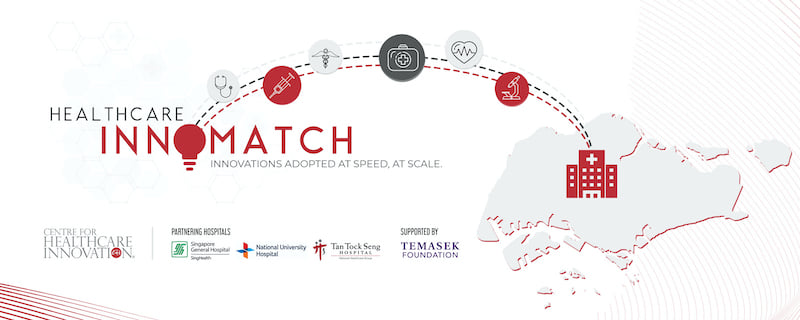| Challenge Owner(s) |
Singapore General Hospital, National University Hospital (NUH), Tan Tock Seng Hospital
|
|---|---|
| Organiser(s) |
Temasek Foundation, Centre for Healthcare Innovation (CHI)
|
| Industry Type(s) |
Digital/ICT, Healthcare & Biomedical
|
| Opportunities and Support | Opportunity to receive funding of up to SGD400,000 each to demonstrate Proof-of-Value (POV) |
| Application Start Date | 23 November 2020 |
| Application End Date | 12 February 2021 |
| Website | Click here to learn more |
About Challenge
The Healthcare InnoMatch 2021 by Temasek Foundation and the Centre for Healthcare Innovation (CHI) is calling for innovative, market-ready or near market-ready solutions to address critical and emerging healthcare needs!
| Challenge Owner(s) | Centre for Healthcare Innovation (CHI), National University Hospital (NUH) |
|---|---|
| Industry Types(s) | Healthcare & Biomedical |
Traditionally, healthcare services are provider-centric as they are inherently manpower-intensive and demand often surpasses supply. With the constant pressure to deliver better care at faster speeds with the aid of technology, services can inadvertently become more impersonal. Therefore, the challenge of innovations like digitalisation lies in facilitating a personalisation of healthcare services to both enhance the patient experience, and improve outcomes.
Desired solutions to improve healthcare digitisation
Solutions should encompass some or all of the following aspects:
- Telehealth-enabled monitoring and/or interventions, for both acute and chronic conditions, improving its accessibility and convenience without sacrificing quality or compromising the experience
- Creating seamless patient journeys and experiences during medical encounters (e.g. automated patient recognition, personal mobile device integration, smart signage and kiosks to cater for patients with different levels of technology adoption)
- Active and productive patient engagement in the co-design of healthcare (e.g. creation of a pervasive and integrated feedback sampling platform across a range of patient touch points, through multiple devices, to collect, classify, and analyse patient feedback for action).
The desired results are better patient health outcomes (including but not limited to clinical, functional and patient reported outcomes) and improved patient experiences.
| Challenge Owner(s) | National University Hospital (NUH), Centre for Healthcare Innovation (CHI) |
|---|---|
| Industry Types(s) | Healthcare & Biomedical |
As medical care becomes more complex and antibiotic resistance increases, the cases of HAI are expected to escalate. The challenge spans, but is not limited to, the early identification & isolation of index cases, ensuring the adequacy of isolation facilities, maintaining the best aseptic techniques, and providing appropriate Personal Protective Equipment along with adequate facilities and equipment. Eliminating HAIs entirely is impossible due to the complex nature of healthcare services. However, it can certainly be better managed and significantly reduced.
Desired solutions to help with HAIs
Solutions should encompass some or all of the following aspects:
- Rapid diagnostics to allow upfront screening and isolation
- Improved design of facilities / equipment (e.g. antimicrobial coated PPE, curtains, bed linen, antimicrobial coated surfaces)
- Disinfection technology
- Improved ways to teach, monitor, and uphold disinfection practices in healthcare workers.
The desired results are better patient health outcomes (including but not limited to clinical, functional and patient reported outcomes) and improved patient experiences. An example is faster and safer care (lower transmission rates, reduced complications, shorter hospital stays).
| Challenge Owner(s) | National University Hospital (NUH), Centre for Healthcare Innovation (CHI) |
|---|---|
| Industry Types(s) | Healthcare & Biomedical |
Frailty is a common geriatric syndrome that is characterised by diminished strength, endurance and physiologic reserves. This means even typically trivial changes in health, such as minor infections or changes in medication, can put a frail person at significant risk of adverse outcomes. It is estimated that approximately 50-90% of hospitalised patients are frail and coping with this condition is hard not only for patients but also their families. Frailty can result in functional decline, longer hospital stays, admission to nursing homes as well as death. While the risk of frailty increases with age, it is not inevitable. If routinely identified and managed, a frail person’s quality of life and wellbeing can be improved and can be supported to live well for longer.
Desired solutions to help with frailty
Solutions should encompass some or all of the following aspects:
- Identification and assessment
- Care plan (e.g. prevention of deconditioning, rehabilitation, physical activity during stay, nutrition, emotional health)
- Care environment
- Patient activation for successful transition back to residential and/or community settings (including proper information flow, providing continued care and supervision).
- Frailty is also often related to sarcopenia (loss of muscle mass and function), and solutions can include prevention of frailty or its progression (e.g. in exercise, social health, nutrition, and dental health).
The desired results are better patient health outcomes (including but not limited to clinical, functional and patient reported outcomes). Some examples are improvement/slowed-progression of frailty, better patient experience (shorter hospital stay and readmissions), or empowering and activating patients.
Sign up for the latest innovation updates
Customise your preferences to receive updates in industries you're interested in.
